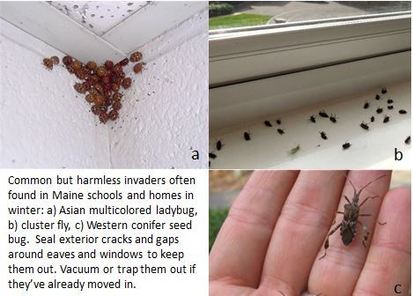 What are those weird insects we find on
windows, floors and light fixtures during the winter?
Some insects such as ladybugs, stink bugs and cluster flies move indoors
in the fall to hibernate for the winter. Unfortunately for those wannabe hibernators,
occupied buildings are too warm to allow a decent winter’s rest. Instead, they
crawl, fly and gather on windows and corners in a confused attempt to get back
outside. What’s a savvy IPM practitioner
to do about these occasional nuisances?
Identify
Them. Send a specimen or a good photo (zoom in and
focus!) to your local Extension office or browse the on-line image gallery at www.gotpests.org. Once you know what critters
you are dealing with, you can take effective action to get and keep them out.
Seal Them Out. Seal entry points on the building exterior such as gaps in
siding, under eaves and around windows and utility lines. This is best done in summer before the insects move
in; as early as mid-August.
Vacuum.
Once these insects have moved into the wall voids, crawl spaces and attics, you
can only remove them as they become active indoors. Vacuum them out regularly
with a HEPA-filter equipped vacuum to capture the allergens and odors along
with the bugs.
Window Traps and Light
Traps. Attaching powder-filled traps, such as the
‘Cluster Buster’, or clear tape-type traps to window panes is an
option for cluster flies and ladybugs. The
tape-type traps are inexpensive but the tendency for captured insects to buzz
and die slowly will be a distraction in some classrooms. Powder traps are more
expensive, but more discreet and maintenance-free for year or more. Electric ultraviolet light
traps attract some flying insects, capturing them with a sticky panel that must be changed regularly. Light traps are most effective when placed 3-5’ high
and away from other light sources such as windows.
Make
them into a Classroom Science Project. Seriously! Counting
insects, recording data, and scientifically evaluating control methods such as
vacuuming or trapping can be an engaging learning opportunity, easily meeting
several components of the Next Generation Science standards. Find lessons and other teaching resources on our IPM Curriculum webpage.
Pesticides. In most cases, pesticides are not effective or necessary. If your school has an
unusually intolerable problem with overwintering insects and you’ve already
tried vaccuuming, sealing and trapping, talk with a licensed pest control
company about a one-time spot application of a registered pesticide, applied to
cracks and crevices under the eaves and around windows, especially on the
sun-exposed, upper stories of the building. This should
be done in mid- to late-August. Be sure to keep records in your pest
activity logbook and send notices to parents and staff if school is in session.
|